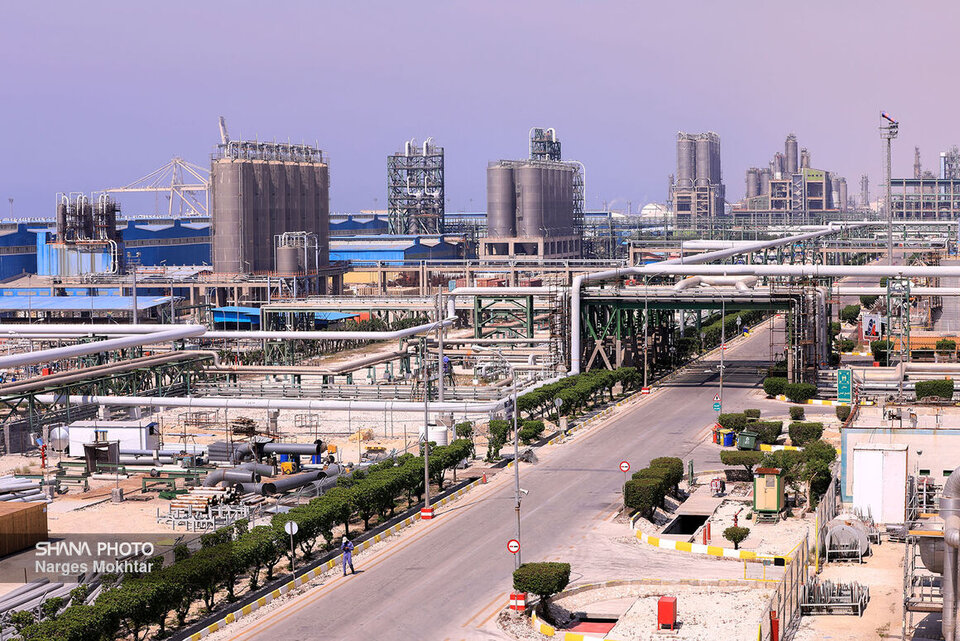Raeisi said operation of the SP14 refinery had materialized by reliance on local knowhow and technical savvy and Iranian engineers without contribution of foreign companies. He added: “Starting up this project is the realization of the slogan ‘We Can’.” Minister Owji also said that SP14 refinery products would be worth $3.5 billion per annum.
With gas find in South Pars, Assaluyeh has become a major petroleum industry zone in Iran. Since 2000s, $150 billion has been invested in South Pars, Kangan and Assaluyeh. Meantime, 2.3 tcm of gas has been totally recovered from South Pars, valued at $414 billion.
Currently 21 petrochemical plants are operating in the Pars Special Economic Energy Zone (PSEEZ), fed by South Pars, supplying 39 million tonnes of products a year.
Gas output at 1bcm/d
The SP14 refinery is the last refinery in the South Pars field. The only undeveloped phase is SP11 which would add 56 mcm/d to the field’s output. SP11 is expected to start producing gas next calendar year (starting on 21 March 2023).
Minister Owji said: “The South Pars gas production capacity currently stands at 705 mcm/d. This [calendar] year we managed to reach a record 1 bcm/d of gas production from all gas fields in Iran.”
He said $2.7 billion had been invested in the onshore sector of SP14, adding: “With the implementation of SP Fourteen, 56 mcm/d of gas is recovered while more than 50 mcm/d of sweet gas would be fed into the Iran Gas Trunk line (IGAT). Furthermore, 75 kb/d of gas condensate is produced from this phase.”
Owji put at $3.5 billion the annual value of SP14 products, noting that full implementation of SP14 would provide 1 million tonnes of ethane and 1 million tonnes of LPG a year to feed petrochemical plants.
The minister said that more than 75% of equipment used in the SP14 refinery had been supplied by local manufacturers.
Touching on the 70% contribution of local manufacturers in oil and gas projects, he said: “In the 13th administration, we have tried to benefit from knowledge-based companies. A total of 550 knowledge-based companies are working in the upstream and downstream petroleum sectors.”
1.2 mcm capacity building
Another project that has become operational is the nine storage tanks in the second phase of Assaluyeh Petrochemical Green Tanks Project with a storage capacity of 414,000 cubic meters of petrochemical products with an investment of more than $95 million. That would bring Iranian petrochemical storage capacity in PSEEZ to 1.2 mcm with more than $620 million investment. The project would bring to 48 the number of storage tanks in Assaluyeh’s petrochemical plants.
Mohammad Reza Yazdani, CEO of Assaluyeh Petrochemical Green Tanks Co. (APGT), described the project as the largest petrochemical storage project, saying: “The availability of enough storage tanks for products ensures manufacturing companies that in case of any disruption in loading and exports they can continue storing products in green tanks.”
48 tanks in 3 phases
The first phase of petrochemical storage tank capacity building in Assaluyeh came online in 2019 with 13 storage tanks holding a total capacity of 370,000 cubic meters. In the second phase, 13 more tanks would be built with a total capacity of 568,000 cubic meters. Given the output of petrochemical companies in Assaluyeh, 9 tanks came online in the second phase with a capacity of 414,000 cubic meters, including 6 storage facilities for methanol and 3 storage facilities for ethylene glycol products. The remaining four tanks would become operational next calendar year.
Investment in the first and second phases totaled $350 million. The second phase involves 22 storage tanks with a capacity of 275,000 cubic meters.
Domestic potential
Yazdani said APGT had, since 2015, been providing exclusive storage services for petrochemical products supplied by the second petrochemical phase of PSEEZ, which are destined for exports. Methanol, propane, butane, various products of ethylene glycol, light naphtha, ethylene, butadiene, styrene monomer, propylene, normal and isobutanol and 2-EH are others stored by APGT at varying volumes ranging from 6,000 to 720,000 cubic meters.
Meantime, $350 million has been invested in building 22 storage tanks (phases 1 and 2) along with communications routes and infrastructure installations. The investment in APGT is borne entirely by Shasta Trading Investment Co., the proprietor of the project.
Yazdani said more than 80% of commodities and equipment in this project had been provided by local manufacturers and suppliers. He said that engagement of local knowledge-based companies cut project costs by 30% in the newly-built 9 storage tanks.


Your Comment